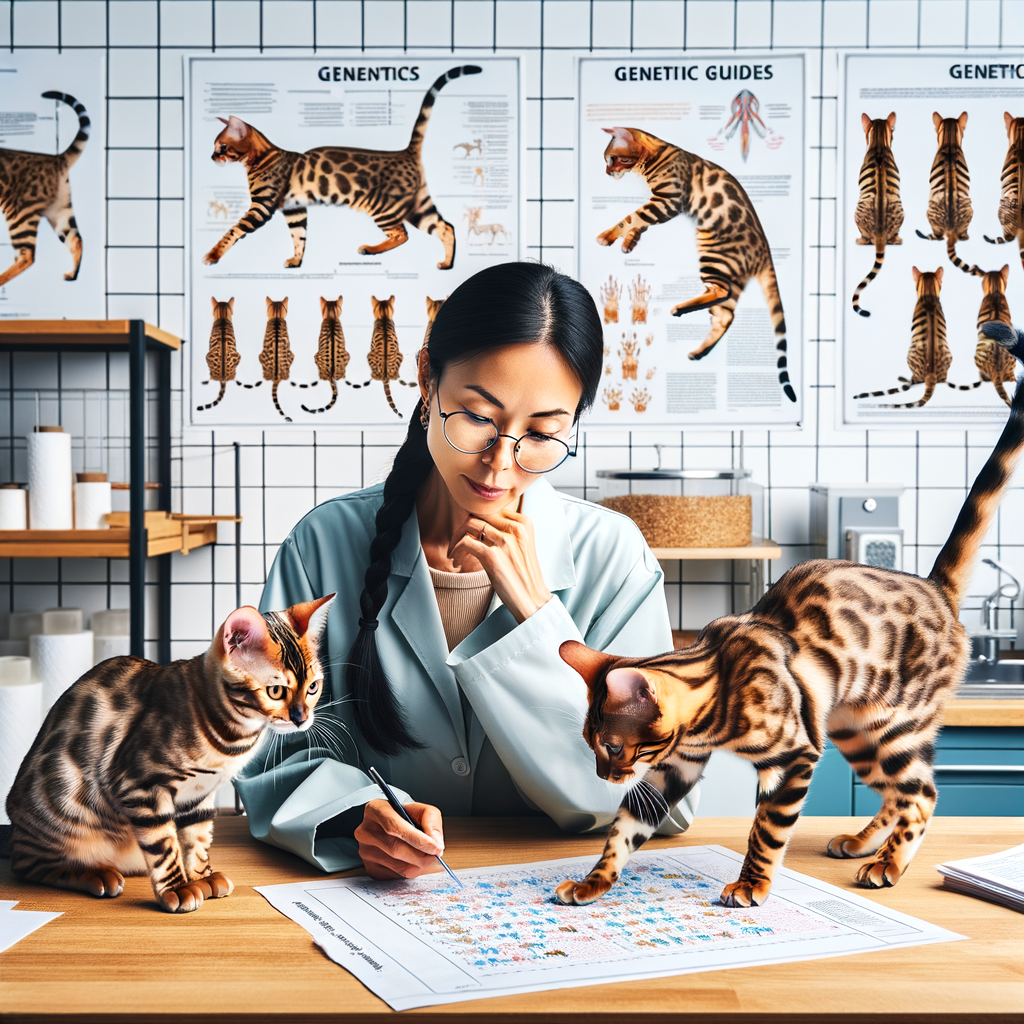
Introduction to Bengal Cat Breeding
Welcome to the fascinating world of Bengal cat breeding. This guide will help you understand the basics of Bengal cat breeding and what makes it unique. Let’s dive in!
-
- Understanding the basics of Bengal Cat Breeding
Bengal cats are a hybrid breed, created by crossing a domestic cat with an Asian leopard cat. This crossbreeding results in a cat that has the wild appearance of a leopard but the gentle nature of a domestic cat. Breeding Bengal cats requires a deep understanding of their genetics, health, and behavior.
Here are some key points to remember:
| Key Point | Description |
|---|---|
| Genetics | Bengal cats have a unique genetic makeup that requires careful breeding to maintain their distinct characteristics. |
| Health | Like all cats, Bengals can be prone to certain health issues. Regular vet check-ups and a healthy diet are crucial. |
| Behavior | Bengals are active and playful. Understanding their behavior can help in breeding healthy and happy kittens. |
-
- Why Bengal Cat Breeding is unique
Bengal cat breeding is unique for several reasons. Firstly, due to their hybrid nature, breeding Bengals can be more complex than breeding other domestic cats. This is because they carry genes from both domestic cats and wild Asian leopard cats. Secondly, Bengal cats have a distinct appearance, with a coat that can have spots, rosettes, or marbling. This unique look is another factor that breeders need to consider.
Moreover, Bengal cats are known for their playful and active nature. They love to climb, jump, and explore their surroundings. This behavior is more similar to wild cats than domestic ones, making Bengal breeding a unique challenge and experience.
Breeding Bengal Cats: A Comprehensive Guide
When it comes to breeding Bengal cats, there are several important steps to consider. This guide will walk you through the process, providing you with the knowledge you need to breed these beautiful cats successfully.
The Bengal Cat Breeding Process
The process of breeding Bengal cats can be broken down into three main steps. These are:
- Choosing the right Bengal cats for breeding
- Understanding the mating process
- Post-mating care
Choosing the Right Bengal Cats for Breeding
The first step in the breeding process is selecting the right cats. Not all Bengal cats are suitable for breeding. It’s crucial to choose healthy cats with good temperaments and desirable traits. Look for cats with clear coats, strong markings, and bright, vibrant colors. Remember, the goal is to produce kittens that will be healthy and have the best possible characteristics of the breed.
Understanding the Mating Process
Once you’ve chosen the right cats, the next step is to understand the mating process. Bengal cats usually reach sexual maturity between 8 and 12 months of age. The female cat, or queen, will go into heat several times a year. During this time, she will be receptive to the male cat, or tom. Mating usually occurs over several days, and it’s important to monitor the cats during this time to ensure everything goes smoothly.
Post-Mating Care
After mating, the queen will go through a gestation period of about 63 to 65 days. During this time, it’s important to provide her with proper nutrition and veterinary care. Once the kittens are born, they will need to be cared for until they are old enough to be placed in their new homes. This includes feeding, socializing, and providing any necessary medical care.
Breeding Bengal cats can be a rewarding experience, but it’s not a task to be taken lightly. It requires a significant commitment of time, resources, and care. However, with the right knowledge and preparation, you can successfully breed these beautiful cats.
Bengal Cat Breeding Techniques
When it comes to Bengal cat breeding, there are two main techniques that breeders use: traditional and modern. Both methods have their own advantages and disadvantages, and the choice between the two often depends on the breeder’s personal preference and experience.
-
- Traditional Breeding Techniques
Traditional breeding techniques for Bengal cats involve selecting two healthy, purebred Bengal cats for mating. The male and female are usually chosen based on their physical characteristics, health, and temperament. The goal is to produce kittens that inherit the best traits of both parents.
One of the key advantages of traditional breeding is that it allows breeders to maintain the unique characteristics of the Bengal breed. However, it also requires a deep understanding of Bengal cat genetics and careful selection of breeding pairs to avoid health issues in the kittens.
-
- Modern Breeding Techniques
Modern breeding techniques, on the other hand, involve the use of advanced genetic testing and artificial insemination. These methods allow breeders to ensure the health of the kittens and to control certain traits more precisely.
For example, genetic testing can help identify potential health issues in the parents before they are bred. This can prevent these issues from being passed on to the kittens. Artificial insemination, meanwhile, allows breeders to control the timing of the breeding process more precisely.
While modern techniques can provide more control and predictability, they also require more resources and expertise. They can also be more expensive than traditional methods.
In conclusion, both traditional and modern Bengal cat breeding techniques have their own merits. The choice between the two will depend on the breeder’s goals, resources, and level of expertise.
Bengal Cat Genetics: A Deep Dive
When it comes to Bengal cats, their unique and stunning appearance is not just a matter of chance. It’s all about genetics. Let’s take a closer look at the fascinating world of Bengal cat genetics.
Understanding Bengal Cat Genetics
Genetics play a crucial role in the breeding of Bengal cats. It’s not just about the physical appearance, but also their health and behavior. Let’s explore this in more detail.
-
- The role of genetics in Bengal Cat Breeding
Breeding Bengal cats is a science. Breeders carefully select parent cats based on their genetic traits to produce kittens with desired characteristics. This can include their coat color and pattern, eye color, and even their temperament. For instance, the distinctive spotted coat of a Bengal cat is a result of specific genetic coding.
-
- Common genetic traits in Bengal Cats
Bengal cats are known for their distinctive traits, many of which are a result of their unique genetics. Here are a few:
-
- Coat Patterns: The most common coat patterns are spotted and marbled, both of which are determined by genetics.
- Eye Color: Bengal cats can have a range of eye colors, including green, gold, and blue. This is also determined by their genes.
- Temperament: While environment plays a role, genetics can influence a Bengal cat’s temperament. Some may be more active and playful, while others may be more relaxed and calm.
Understanding the genetics of Bengal cats is not just fascinating, but also crucial for responsible breeding. By knowing what traits are passed on from generation to generation, breeders can ensure the health and well-being of these beautiful creatures.
Genetic Challenges in Bengal Cat Breeding
When it comes to Bengal cat breeding, understanding the genetic challenges is crucial. These beautiful cats, known for their striking patterns and playful personalities, can sometimes face certain genetic disorders. It’s important for breeders to be aware of these potential issues and take steps to mitigate the risks.
- Genetic disorders in Bengal CatsLike all breeds, Bengal cats can be prone to specific genetic disorders. Two of the most common are Progressive Retinal Atrophy (PRA) and Polycystic Kidney Disease (PKD). PRA is a condition that can lead to blindness, while PKD can cause kidney failure. These conditions can be detected through genetic testing, allowing breeders to make informed decisions about their breeding programs.
Genetic Disorder Description Progressive Retinal Atrophy (PRA) A condition that can lead to blindness. Polycystic Kidney Disease (PKD) A disorder that can cause kidney failure. - How to mitigate genetic risksThere are several ways to mitigate the genetic risks in Bengal cat breeding. The most effective method is through genetic testing. By testing potential breeding pairs for these disorders, breeders can ensure they are not passing on these conditions to the kittens. Additionally, maintaining a diverse gene pool within the breeding program can help reduce the risk of these and other genetic disorders.
It’s also important for breeders to stay informed about the latest research in feline genetics. This can help them make the best decisions for their breeding programs and the overall health of the Bengal cat breed.
Bengal Cat Breeding Tips and Tricks
When it comes to Bengal cat breeding, there are several key factors to consider. These include selecting the right breeding pair, providing proper care and nutrition, and understanding the signs of a successful breeding. Let’s delve into these essential tips for Bengal cat breeders.
Essential Tips for Bengal Cat Breeders
-
- Choosing the Right Breeding Pair
The first step in successful Bengal cat breeding is selecting the right pair. This involves considering the cats’ health, age, and genetics. For instance, both cats should be healthy and free from any genetic diseases. Additionally, the female cat should be at least one year old, while the male cat should be between one and a half to two years old.
-
- Providing Proper Care and Nutrition
Proper care and nutrition are crucial for the health of both the parent cats and the kittens. This includes providing a balanced diet rich in proteins and essential nutrients, regular vet check-ups, and ensuring the cats have a comfortable and stress-free environment. Remember, a healthy cat is more likely to produce healthy kittens.
-
- Understanding the Signs of a Successful Breeding
Recognizing the signs of a successful breeding can help you prepare for the arrival of kittens. These signs may include changes in the female cat’s behavior, such as increased appetite, nesting behavior, and a noticeable increase in weight. It’s important to consult with a vet if you notice any unusual behavior or signs of distress in your cat.
In conclusion, Bengal cat breeding requires time, effort, and a deep understanding of the breed. By following these tips, you can ensure a successful breeding process and the birth of healthy, beautiful Bengal kittens.
Bengal Cat Breeding: Behind the Scenes
Let’s take a closer look at what happens behind the scenes in the world of Bengal cat breeding. We will explore the day-to-day life of a Bengal cat breeder and discuss the challenges and rewards of this unique profession.
-
Day-to-day life of a Bengal Cat Breeder
The life of a Bengal cat breeder is far from ordinary. It begins early in the morning with feeding the cats and cleaning their living spaces. Breeders must ensure that each cat is healthy and comfortable, which often involves regular vet check-ups and plenty of playtime for socialization.
Throughout the day, breeders monitor the cats for any signs of illness or distress. They also spend time researching and learning about Bengal cat genetics to make informed decisions about breeding pairs. It’s a job that requires both passion and knowledge.
-
The Challenges and Rewards of Bengal Cat Breeding
Breeding Bengal cats is not without its challenges. Breeders must navigate the complexities of cat genetics, deal with unexpected health issues, and invest significant time and resources into caring for the cats.
Despite these challenges, the rewards are immense. There’s the joy of watching kittens grow and develop, the satisfaction of knowing you’re contributing to the health and diversity of the breed, and the pleasure of sharing these beautiful cats with others. As one breeder put it, “The challenges are many, but the rewards are worth every bit of effort.”
Behind the scenes, Bengal cat breeding is a world of dedication, knowledge, and love for these unique cats. It’s a profession that demands a lot but gives back in countless ways.
Conclusion: The Art of Bengal Cat Breeding
As we draw to a close on our comprehensive guide on Bengal cat breeding, it’s important to reflect on the key takeaways and understand why this practice is truly an art.
-
- Recap of Bengal Cat Breeding Information
We’ve delved into the fascinating world of Bengal cat breeding, covering everything from the basics to the complexities of genetics. We’ve learned that breeding these exotic felines requires a deep understanding of their unique traits, health considerations, and genetic makeup. We’ve also explored practical tips and tricks to ensure successful breeding.
-
- Why Bengal Cat Breeding is an Art
Bengal cat breeding is more than a science; it’s an art. It requires patience, dedication, and a keen eye for detail. It’s about creating a balance between the cat’s health and the preservation of its unique characteristics. It’s about understanding the nuances of their behavior and using this knowledge to enhance their quality of life.
Just like an artist, a Bengal cat breeder must be passionate, observant, and willing to learn. They must be able to adapt, make informed decisions, and above all, respect the animals they work with. This is what makes Bengal cat breeding a true art form.
In conclusion, Bengal cat breeding is a rewarding but complex endeavor. It’s an art that requires both scientific knowledge and a deep love for these unique creatures. With the right approach, it can lead to the creation of healthy, happy, and truly extraordinary Bengal cats.














